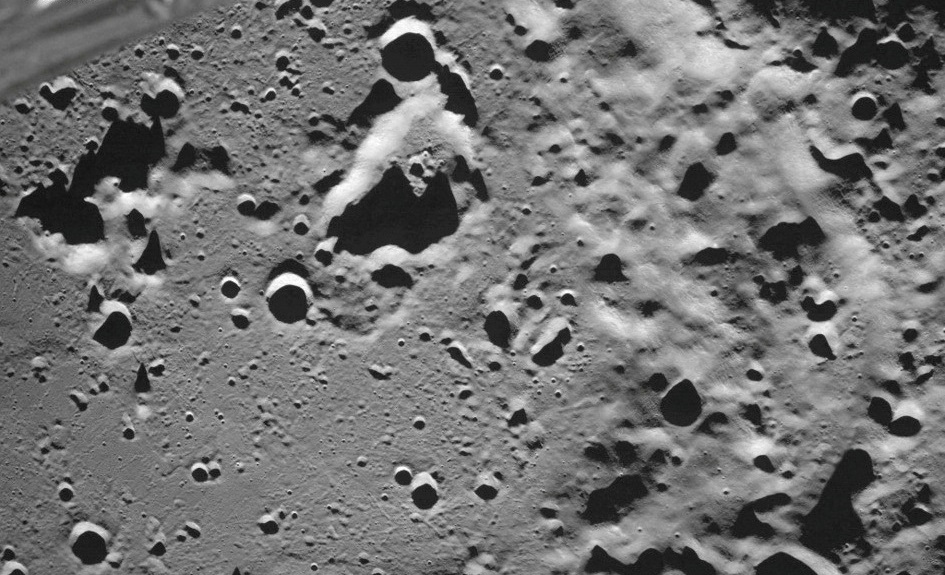
FILE PHOTO: An image from the camera of the lunar lander Luna-25 shows the Zeeman Crater at the far side of the moon on August 17, 2023. This image is provided by Roscosmos/Manual focus editors via Reuters. Third party. Compulsory loan./File photo Get license rights
BENGALURU/WASHINGTON, Aug 22 (Reuters) – The space race is about science, national pride and a new frontier: money, as India aims to land first on the moon’s south pole this week.
India’s Chandrayaan-3 will land on the moon’s south pole on Wednesday. If it succeeds, analysts and executives expect an immediate boost to the South Asian country’s nascent space industry.
Russia’s Luna-25, which launched two weeks ago, was on track to get there first — before the lander crashed out of orbit, possibly carrying funds for a successor mission with it, analysts say.
The sudden race to reach a previously unexplored region of the moon is reminiscent of the 1960s space race between the United States and the Soviet Union.
But now space is a business, and the moon’s south pole is a prize, as planners hope the water ice there will support future lunar colonies, mining operations and missions to Mars.
Driven by Prime Minister Narendra Modi, India has privatized space launches and wants to open up the sector to foreign investment, aiming to increase its share of the global launch market fivefold within the next decade.
If Chandrayaan-3 succeeds, analysts expect India’s space industry to capitalize on its reputation for cost-competitive engineering. The Indian Space Research Organization (ISRO) has spent just $74 million on this mission.
NASA, by comparison, is on track to spend about $93 billion on its Artemis moon program by 2025, the U.S. space agency’s inspector general has estimated.
“The moment this mission succeeds, it raises the profile of everyone associated with it,” said Ajay Lele, a consultant at the Manohar Parrikar Institute for Defense Studies and Analyses, New Delhi.
“When the world sees a mission like this, they don’t see ISRO alone.”
Crisis in Russia
Despite Western sanctions over its war in Ukraine and increasing isolation, Russia has managed to launch a moonshot. But some experts doubt the ability to fund a successor to Luna-25. Russia did not disclose how much it spent on the mission.
“Expenditures for space exploration are systematically reduced every year,” said Vadim Lukashevich, an independent space expert and author based in Moscow.
He added that the Luna-25 is “highly unlikely” as Russia’s budget priority for the war in Ukraine.
Russia was considering contributing to NASA’s Artemis program until 2021 when it said it would partner with China’s lunar program instead. Few details of that effort have been released.
China made the first soft landing on the far side of the moon in 2019 and plans more missions. Space research firm Euroconsult estimates that China will spend $12 billion on its space program by 2022.
NASA’s Playbook
But by opening it up to private money, officials there say NASA has given India a playbook to follow.
Elon Musk’s SpaceX, for example, is developing the Starship rocket for its satellite launch business, and NASA is sending astronauts to the surface of the moon under a $3 billion contract.
Beyond that deal, Musk has said SpaceX will spend about $2 billion on Starship this year.
U.S. space companies Astrobotic and Intuition Engines ( LUNR.O ) are developing lunar landers that are expected to launch to the moon’s south pole by the end of the year or in 2024.
And companies like Axiom Space and Jeff Bezos’ Blue Origin are building successors to the International Space Station with private funding. On Monday, Axiom raised $350 million from Saudi and South Korean investors.
Space is dangerous. India’s last attempt failed in 2019, the same year an Israeli startup failed to land on the moon with private funding. Japanese startup Icespace ( 9348.T ) failed in its bid to land this year.
“Landing on the moon is difficult,” said Bethany Ellman, a professor at the California Institute of Technology who is working with NASA on a 2024 mission to map the moon’s south pole and its water ice.
“For the last few years, the moon seems to be eating the spacecraft.”
(This story has been revised to include Reuters Instrument index on paragraph 21)
Editing by Kevin Krolicki and Clarence Fernandez
Our Standards: Thomson Reuters Trust Principles.
